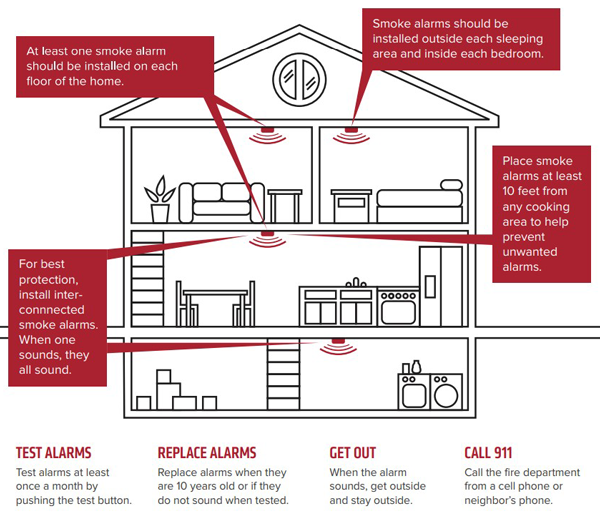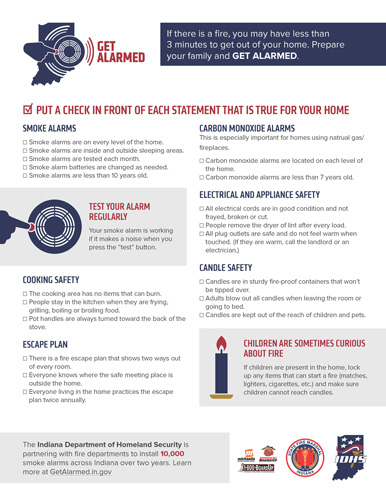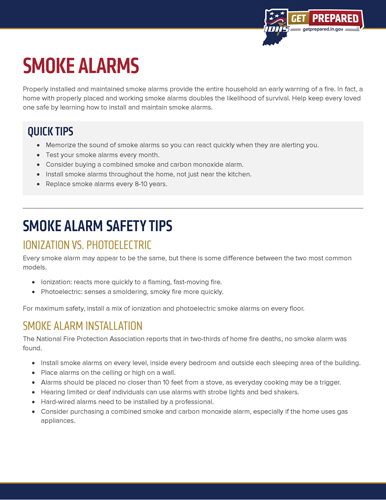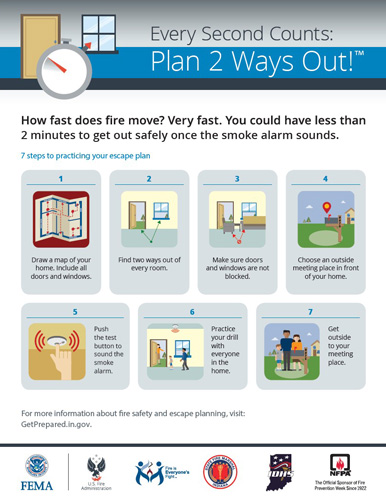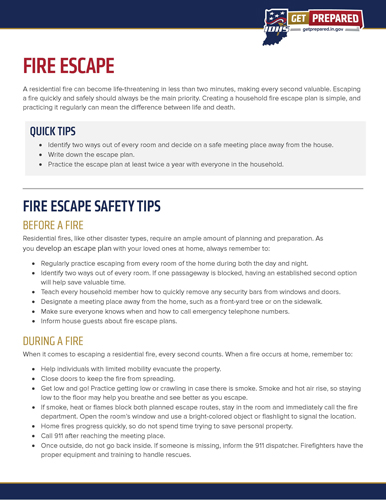Get Alarmed
- Get Prepared
- Fire Safety
- Current: Get Alarmed
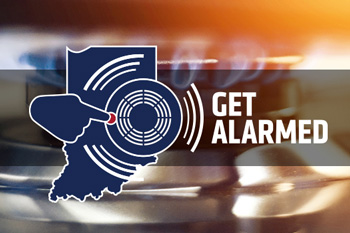
About the Get Alarmed Campaign
In late 2018, the Indiana Department of Homeland Security received a federal Fire Prevention and Safety Grant to dedicate resources toward reducing injury and preventing fire deaths in high-risk populations. The Indiana State Fire Marshal tracked 84 residential fire fatalities in 2023, and about two-thirds of fatal fires nationally occur in homes with no working smoke alarms. To help prevent these incidents, the Get Alarmed campaign began as a smoke alarm installation program working closely with fire departments to distribute the alarms across the state at no cost.
"The first phase of Get Alarmed successfully connected Hoosiers with life-saving smoke alarms that will help protect their families for years to come," said State Fire Marshal Stephen Jones. "IDHS remains committed to these efforts and now turns to making sure all people in Indiana know how to prevent fires and what to do in case they happen."
In addition to working with fire departments and other partners on smoke alarms, Get Alarmed emphasizes fire safety education. Read more about smoke alarms below and fire prevention and preparedness on Get Prepared.
In addition to working with fire departments and other partners on smoke alarms, Get Alarmed emphasizes fire safety education. Read more about smoke alarms below and fire prevention and preparedness on Get Prepared.

Smoke Alarm Safety Tips
Quick Tips
- Memorize the sound of smoke alarms so you can react quickly when they are alerting you.
- Test your smoke alarms every month.
- Consider buying a combined smoke and carbon monoxide alarm.
- Install smoke alarms throughout the home, not just near the kitchen.
- Replace smoke alarms every 8-10 years.
The Sounds of Fire Safety
Learn the Sounds
- 3 beeps and a pause: A smoke alarm is sounding and you need to get outside, call 911 and stay outside.
- 4 beeps and a pause: A carbon monoxide alarm is sounding and you need to get outside, call 911 and stay outside. Carbon monoxide is a colorless, odorless gas that can poison you before you understand what is happening.
- 1 chirp every 30–60 seconds: An alarm's battery is low and needs to be changed.
- If the alarm continues to chirp after the battery is replaced, then the alarm is at the end of its life and needs to be replaced.
Listen to the Sounds
Select the sounds below to hear them.
- Smoke alarm beeping
 : There is smoke or fire.
: There is smoke or fire. - Carbon monoxide alarm beeping
 : There is a dangerous level of carbon monoxide present.
: There is a dangerous level of carbon monoxide present. - Alarm chirp
 : The battery is low and needs replaced.
: The battery is low and needs replaced. - Combination smoke/carbon monoxide alarm with voice command
 : The alarm's voice may say "Fire!" or "Warning: Carbon Monoxide!" after the beeps to alert you to the danger.
: The alarm's voice may say "Fire!" or "Warning: Carbon Monoxide!" after the beeps to alert you to the danger.
What's That Sound?
Can you tell the difference between a carbon monoxide alarm, microwave and a smoke alarm? Watch the video below to test yourself!
Alarm Buying, Maintenance Tips
- Alarms should be replaced every eight to 10 years, and for smoke alarms that use traditional batteries, batteries should be changed twice a year.
- Smoke alarms should be tested every month.
- Ionization and photoelectric smoke alarms are better at detecting different kinds of potentially fatal fires. The U.S. Fire Administration recommends every household be equipped with both kinds of alarms, or dual-sensor alarms.
- Consider purchasing a combined smoke and carbon monoxide alarm, especially if the home uses gas appliances.
- For hearing-limited or deaf individuals, install interconnected smoke alarms and consider buying a strobe alarm or bed-shaking alarm.
- Contact your local fire department if you need help acquiring smoke alarms.
How to Install Alarms
- Install smoke alarms on every level, inside every bedroom and outside each sleeping area of the building. Similarly, install carbon monoxide alarms outside each sleeping area and on every level.
- Place smoke alarms on the ceiling or high on a wall.
- Follow the manufacturer’s instructions for mounting height of your carbon monoxide alarm. About 5 feet above the floor may be recommended.
- Smoke alarms should be placed no closer than 10 feet from a stove, as everyday cooking may cause unnecessary triggers. Similarly, carbon monoxide alarms should be placed near, but not immediately next to, fuel-burning appliances like furnaces.
- Hard-wired alarms need to be installed by a professional.
- Contact your local fire department if you need help installing smoke alarms.
Resources
More About Get Alarmed
Hours
8 a.m. – 4:30 p.m. Monday – Friday
except state-observed holidays
Indiana Dept. of Homeland Security
Indiana Government Center-South, Room E208
302 W. Washington St.
Indianapolis, IN 46204-2739
Call us: 317-232-2222
Email us: getalarmed@dhs.in.gov
IDHS' $521,000 federal grant supported the purchase of 10,000 smoke alarms with 10-year lithium ion batteries over a two-year period. The Get Alarmed campaign has been working closely with fire departments since 2019 to distribute the alarms across the state at no cost.
The Indiana State Fire Marshal is accepting requests from fire departments to install smoke alarms in their communities. If interested, please submit a request via the application linked below to be contacted about how to participate in the Get Alarmed campaign and receive smoke alarms. Individuals who want smoke alarms can request them through their local fire department.
Note: The Get Alarmed campaign has distributed all of its smoke alarm inventory. IDHS is working to resupply its inventory, but fire departments should keep this in mind when requesting additional alarms.
Get Alarmed Installation Partners


